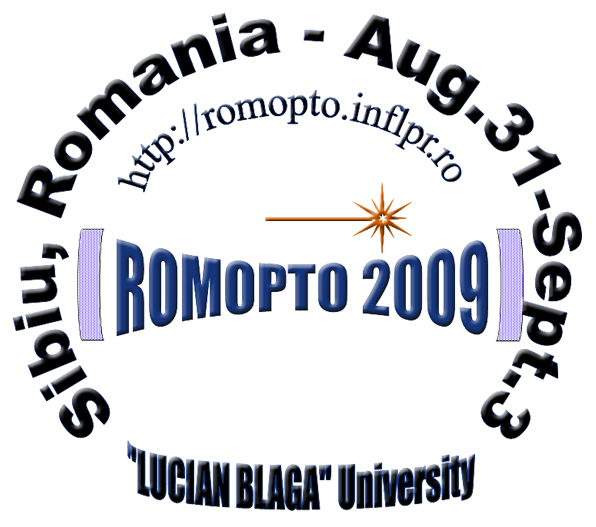"Micro- to Nano-Photonics II - ROMOPTO 2009"
General Information
Sibiu City Conference Location Accommodation Transportation Maps Touristic tips
Sibiu City
Sibiu lies in the very centre of Romania, in an area surrounded by mountains. The city of Sibiu is the most important city in the county of Sibiu. It is situated in the longitude of 24° 29' East (in line with Lyon) and in the latitude of 45° 48' North (in line with Athens), near the geographical center of Romania. (See the map).
Set in the Cibin Depression, the city is near to Fagaras Mountains (about. 20 km), Cibin Mountains (12 km), and Lotrului Mountains (about 15km), which border the depression in the southwestern part. The north and east boundaries of Sibiu territory are settled by Târnavelor Plateau which descends to the Cibin Valley through Gusteritei Hill.
The old city was probably built near the Roman city of Caedonia, which might have been deserted at the beginning of the Middle ages, shortly after the Roman withdrawal. The actual city was built in 1192 by German colonists. This accounts for the German name of the city - Hermannstadt - and for distinctly German "character" of the city.
Currently the city is inhabited by a population of around 180 000 people, consisting of Romanians, Germans, Hungarians and others.
Sibiu is one of the cultural, eclesiastical and political centre of the Romanian and German population. It is here, in Sibiu/Hermannstadt, that the most representative institutions of Transylvania are located: the Mitropolia of Transylvania, Crisana and Maramures, the Evangelical Episcopacy, the German Democratic Forum and a General Consulate of Germany in Romania. Sibiu was designate European Capital of Culture in 2007, together with Luxembourg and the Grand Region of Luxembourg.
The climate here is temperate-continental with average temperature of 8,9° C. The lowest temperature (-31° C) was recorded on January the 4th 1929, whereas the highest (37,5° C) was recorded on July the 25th 1987.
The multi-annual average of precipitation is 662 l/mp, and the number of days of hard frost is about 120 / year.
You can exchange money at banks and privately owned bureaux de change, called "Casa de schimb valutar" Usually there is no commision charged for transition.
Not all the banks exchange travelers checks.
The Romanian currency is called LEU(RON) and is the only currency accepted in shops and restaurants. The most accepted foreign currency are the American dollar and the Euro, so be sure that you have some of these before enter the country.
<--Page Top-->
Conference Location
The International Conference in Optics ROMOPTO 2009 is held at the "Lucian Blaga" University in Sibiu*, "Hermann Oberth" Faculty of Engineering**.
* "Lucian Blaga" University - 10 Victoriei Boulevard, Sibiu
Tel: 40-269-21 79 89, Fax: 40-269-21 78 87
Web Site: http://www.ulbsibiu.ro
** "Hermann Oberth" Faculty of Engineering - 4 Emil Cioran Str., Sibiu
Tel: 40-269-21 79 28, Fax: 40-269-21 27 16
e-mail: inginerie@ulbsibiu.ro
The University campus makes use of 22 buildings, 10 faculties and one college, specialized libraries and one Central University Library.
<--Page Top-->
Accommodation
Accommodation in the hotels specially reserved for the Conference will be available, student hostels as well, at very convenient prices.
More information about Sibiu city and places nearby can be found here.
Information about the history and landmarks of Alba-Iulia city is available here.
<--Page Top-->
Transportation
Sibiu is situated at 282 km far from Bucharest, has a local airport, but not all the international flies are connected to Sibiu. Sibiu International Airport is situated at 5 Km from Sibiu and offers regular flights to Bucharest, Munich and Italy. Cibin river and some roads of national and international interest run through Sibiu which is also an important city for the railway transportation, being the meeting point of routes from east-west and north-south.
More information about how to get there can be found here.
The International Airport Otopeni - Bucharest is situated at about 20 km far from the center of the city. Bus nr. 783 is available at every 15 minutes, at the exit from the airport.
H O W T O G E T H E R E
By plane to Bucharest:
The main international airport of Romania is Henri Coanda Otopeni International Airport , in Bucharest. It offers daily connections with every major city of Europe and with New York (JFK). During the summer season connections are usually added. Bucharest is 282 km from Sibiu, that can be reached within 5-6 hours using express trains or buses.
Inside Bucharest: from the airport to the train station:
The train station, Bucuresti Nord, and the bus station are located next to each other, in Bucharest downtown. There are two ways to reach those from the airport.
Using local transport. Take the bus, EXPRES 783 ( detailed scheduler here ) from the airport to Piata Victoriei station (about 20-30 min, depending on traffic). Then with the subway (First subway 05:00 - Last subway 23:30) from Piata Victoriei to next station, Bucuresti Nord (~3 min). The fares are, for the Expres bus magnetic cards: 2 trips about 7 RON, and for the Metrorex subway card: 2 trips about 2.5 RON.
By cab. Be careful for taxi drivers with high fairs. If you are not sure ask for information in the airport. The trip to Bucharest downtown (Railway station Bucharest Nord) is approx. 20 km takes 30-40 min (depending on traffic)..
By train from Bucharest to Sibiu:
Train schedules can be checked, from the Romanian Railway Company C.F.R (note: Bucharest should be typed in Romanian: Bucuresti).
By bus from Bucharest to Sibiu:
The bus for Sibiu can be taken from Militari Bus Terminal (Iuliu Maniu Blvd., #141. 6th District, Tel: +40 21 434 17 51) located in Bucharest West. We recommend two companies providing confortable transport from Bucharest to Sibiu: Dacos S.R.L and Transmixt.
From Bucharest Airport to Militari Bus Terminal:
Local transport. Take EXPRES 783 bus to Piata Unirii station. Then take the subway, Piata Unirii subway station, to Pacii subway station (~40 min).
By cab. About 40-50 min. (depending on traffic). There is only one cab company agreed inside the airoport (Fly Taxi). Cabs from other companies can be found in the parking area, just in front of Airoport Exit.
By plane directly to Sibiu:
The Sibiu International Airport is situated at 5 km from city centre with direct access from main highway, E68.
Directions to "Lucian Blaga" University Rectorate
<--Page Top-->
Maps
Bucharest
Bucharest Subway
Bucharest Bus
Sibiu
"Lucian Blaga" University Locations
<--Page Top-->
Touristic tips
SIBIU city description
Sibiu is beautiful; indeed a delight for the eyes.
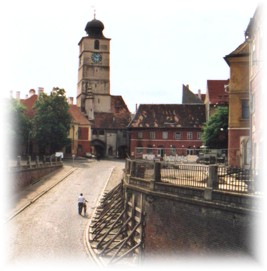
The city displays to visitors an old, historical area, where they can roam narrow and crooked streets, meandering by bastions and brick towers, by old-gabled houses pockmarked with medieval windows.
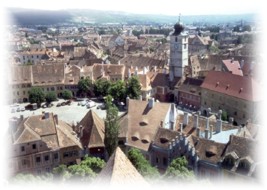
Tunnels and archways, towers and fortifications bear the mark left by the passing of time.
Milestones in SIBIU/HERMANNSTADT
- 1292 - The first hospital in Romania.
- 1380 - The first documented school in Romania.
- 1494 - The first pharmacy in Romania.
- 1534 - The first papermill in Romania.
- 1544 - The first book in Romanian is printed here.
- 1551 - The first experiment with rockets in the world by Conrad Hass
- 1671 - The methane gas resource is discovered near Sibiu
- 1782 - Franz Joseph Müller discovers the chemical element Telur in Sibiu
- 1795 - At Cisnadie is installed the first lightning rod in SE Europe.
- 1797 - Samuel von Hahnemann opens the world first laboratory of homeopathy
- 1817 - Brukenthal Museum, the first museum in Romania
- 1852 - First issue of "Telegraful Roman" the oldest newspaper in SE Europe
- 1859 - The Liars Bridge, the first cast-iron bridge in Romania
- 1875 - The first engineering manufacturing in Transylvania
- 1896 - The first electric power in Romania and the first power line in this part of Europe.
- 1904 - The second city in Europe where an electric tramway is used
- 1928 - The first Zoological Garden in Romania
- 1989 - The second city in Romania rising against the Communist Regime.
Historic Centre and Old Town
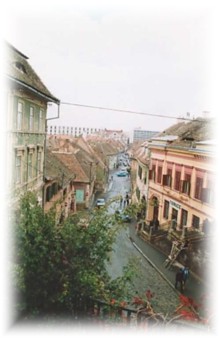
The city has two easily walkable levels: the 'upper town', which contains most of Sibiu's historic sights, and the 'lower tower', which is a charming aggregation of old houses and cobbled squares.
The lower town had been developed around the first town fortifications and here you can find the oldest streets in Sibiu: Strada 9 Mai, Strada Ocnei and Strada Turnului.
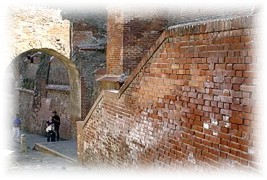 The Citadel of Sibiu was for centuries one of the largest and best fortified in Europe. The Citadel was surrounded by walls and defence towers, some of these are still very well preserved and give us a clue of how they looked like hundreds of years ago.
The Citadel of Sibiu was for centuries one of the largest and best fortified in Europe. The Citadel was surrounded by walls and defence towers, some of these are still very well preserved and give us a clue of how they looked like hundreds of years ago.
The third fortification of walls were built in 14th century and were consolidated in the 17th century. Most of the remaining of Sibiu's medieval fortress wall and towers stand along Strada Cetatii and Bd. Coposu.
Museums
Sibiu has ten museums and permanent exhibitions. Among them:
Brukenthal Museum
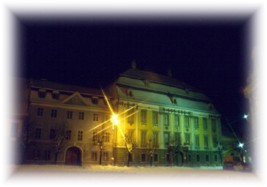
The Brukenthal Palace was built by Samuel Brukenthal, governor of Transylvania, in baroque style between 1777 and 1787.
He gathered here a vast collection of paintings, antiques, coins, and rare books.
Palace hosts the Brukenthal Museum which includes the Art Gallery and the Exhibition of Ethnography and Folk Arts.
ASTRA Museum
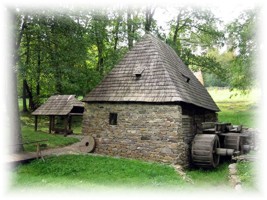
Built between 1963 and 1969 and opened for the public in 1967, the Museum offers an elaborate demonstration of pre-industrial folk technology and development in Romania.
Divided in 6 sections includes 340 buildings, including watermills and windmills, gigantic wine, fruit and oil presses, fueling mills, forges and 16,000 inventory values, structures representing architectural styles from many parts of Romania
History Museum
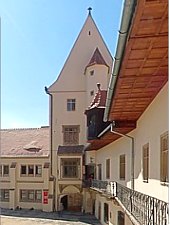
Located in a historic building used to be the Old Town Hall for 450 years, the Museum of History owns a rich collection counting 250,000 exhibits from various fields: medieval, numismatics, sigillography, medals, antique and medieval lapidariums.
The building was built in 16th century in Renaissance and Gothic style.
Churches
In Sibiu are found 15 historic churches, some of them of invaluable importance and some of them are masterpieces of architecture. Among them:
Evangelic Cathedral
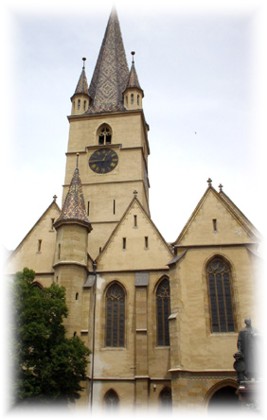
This impressive cathedral was built in 1520 on the place of an old Romanic basilica from the 12th century.
With five pointed towers it is one of the most impressive building in Sibiu.
The cathedral has a choir loft on the south side with a beautiful fan-vaulted ceiling. There is as well an immense Baroque organ designed by a German master in 1671.
Six thousands pipes were installed in 1914 making it the largest in Romania.
Catholic Church
Was built between 1726 and 1738 in a baroque style with classic decorations.
The tower was attached to the nave in 1738 and one year later a cross was seated on the top.
The complete renovated interior is magnificent with its gold-laced walls and colorful ceiling frescoes. Intricate stone carvings cover much of the nave and the side altars and colonnades of pink marble will leave you breathless.
Orthodox Cathedral
Built between 1902 - 1906 in a similar style with the Saint Sofia Cathedral from Istanbul.
Everybody agrees that this copy looks very much alike the original.
This is the second largest Orthodox Cathedral in Romania.
Surrounding Regions
The region surrounding Sibiu represents a geographical historical and ethnographical entity, including many tourist attractions. The south - eastern part of Transylvania, corresponding to the area where German communities have been colonized (Flandrens, Teutons, Saxons) by the kings of Hungary, has a specific character. It is conferred by the frequency of the fortified churches, dating since the XIIth - XVIth centuries, present in most of the villages colonized by the German population. Such church - castles are found in other parts of the medieval Europe too, but their frequency and degree of preservation is here greater then anywhere in the world.
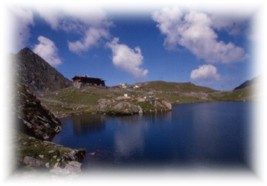 |
 |
 |
 |
You must see:
- Mãrginimea Sibiului
- Fãgãras Mountains
- Pãltinis
- Ocna Sibiului
We hope you will enjoy the trip to SIBIU and you will comeback soon.
<--Page Top-->
